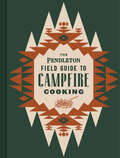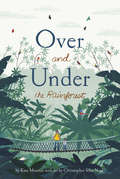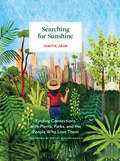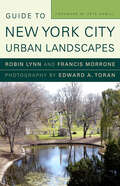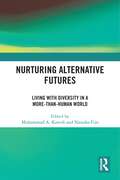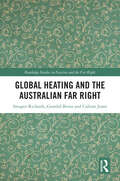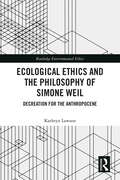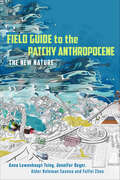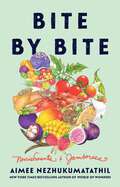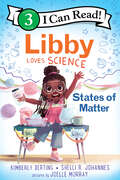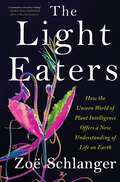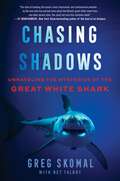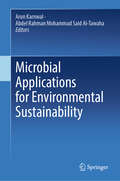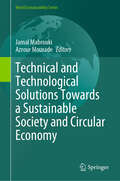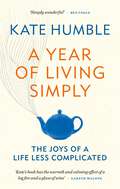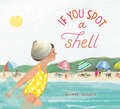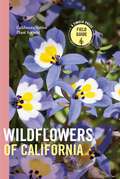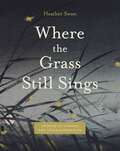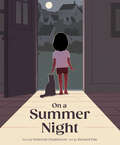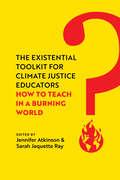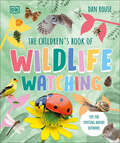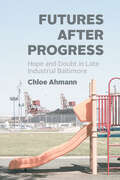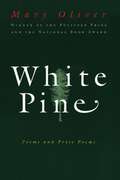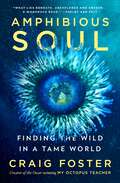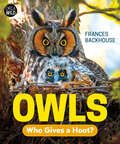- Table View
- List View
The Pendleton Field Guide to Campfire Cooking
by Pendleton Woolen MillisFrom beloved heritage brand Pendleton comes this collection of delicious, family-friendly recipes to elevate any outdoor excursion.Brimming with Pendleton's signature patterns and timeless wisdom, this handsome book is a wonderful companion for families and friends who love spending time in nature. Discover expert tips on how to prep ingredients ahead of time, easily transport supplies, and cook over an open fire or camping stove. Come together around the campfire with more than 30 delicious recipes for outdoor adventures, including:• Skillet Hash with Sausage and Eggs• Campfire Grilled Pizza• Charred Corn Salad with Spices• Pendleton Campfire Popcorn• Giant Snickerdoodle S'mores• And so much more.BELOVED BRAND: For over 150 years, Pendleton Woolen Mills has been one of America's most beloved heritage brands. Known for their woolen blankets and clothing, they are celebrated by people who love the great outdoors.FAMILY FUN: These family-friendly recipes are the perfect way to bring everyone together before a day of adventure or after a day of fun in the outdoors. Making the dishes together is an easy activity for everyone to participate in and offers tons of opportunities to bond with family or friends.BEAUTIFUL TO DISPLAY: Featuring more than 30 delicious, filling recipes in a hardcover package with a cloth cover and lovely textured details, this eye-catching book is the perfect accessory for any outdoor occasion or mountain home and makes for a wonderful gift for those who enjoy the natural world.Perfect for:• Fans of Pendelton• Fans of nature, campers, and the outdoors• Summertime vacationers• Families who love to travel
Over and Under the Rainforest (Over And Under Ser.)
by Kate MessnerPart of the critically acclaimed Over and Under series!Award-winning duo Kate Messner and Christopher Silas Neal take readers on a thrilling tour of one of the most diverse ecosystems on planet earth: the rainforests of Central America. Discover the wonder that lies hidden among the roots, above the winding rivers, and under the emerald leaves of the rainforest.• Features animals like the slender parrot snake to the blue morpho butterfly• Explores the canopies, where toucans and pale-billed woodpeckers chatter and call• Other animals include capuchin monkeys who swing from vines and slow-moving sloths who wait out daily thunderstormsUnder the canopy of the rainforest hundreds of animals make their homes, but up in the leaves hides another world.This stunning read is perfect for kids who can't get enough of the rainforest and all the animals living in it. • Equal parts educational and beautiful, this book is perfect for parents and grandparents, as well as librarians, science teachers, and educators.• A great book for kids who love nature, rainforests, animals, and learning more about the world• Perfect for children ages 5 to 8 years old• You'll love this book if you love books like The Big Book of Bugs by Yuval Zommer, The Animal Book by Lonely Planet Kids, and A Butterfly Is Patient by Dianna Aston.
Searching for Sunshine: Finding Connections with Plants, Parks, and the People Who Love Them
by Ishita JainWhen Ishita Jain relocated to the visually overwhelming and concrete-filled New York City from New Delhi, India, she found solace in parks and gardens and started thinking about how important these places are to city residents' sense of peace. In Searching for Sunshine, Jain follows her curiosity and creativity to provide a vibrant compilation of essays, illustrations, and interviews centered around the simple yet compelling theme of why and how plants and green spaces create such meaning for us.Whether living in a setting that is urban, rural, or somewhere in between, everyone can find enjoyment in the beautiful illustrations and stories gathered here. Featuring conversations with experts and plant-lovers alike, including scientists at the New York Botanical Gardens, groundskeepers at the famed Green-Wood Cemetery, shoppers at the beloved Union Square Greenmarket, a director of NYC Parklands, a florist, and more, Jain's exploration of plants and parks in New York City demonstrates how nature is vital to all experiences of our lives.
Guide to New York City Urban Landscapes
by Robin Lynn Francis MorroneA tour of not-to-be-missed public places—parks, plazas, memorials, streets—that shape the New York experience. The thirty-eight urban gems covered here range from newly created linear spaces along the water’s edge, such as Brooklyn Bridge Park and the East River Waterfront Esplanade, to revitalized squares and circles, such as those at Gansevoort Plaza in the Meatpacking District and Columbus Circle, to repurposed open spaces like the freight tracks, now the High Line, and Concrete Plant Park in the Bronx. Readers can discover midtown atriums, mingle with the crowds in Union Square, travel offshore to nearby Governors Island, and enjoy the vistas of historic Green-Wood Cemetery. Pete Hamill writes in his foreword, “I’ve . . . made a list of new places I must visit while there is time. With any luck at all, I’ll see all of them. I hope you, the reader, can find the time too.” Concise descriptions, helpful maps, and vivid photographs capture the New York urban scene.
Nurturing Alternative Futures: Living with Diversity in a More-than-Human World
by Muhammad A. Kavesh Natasha FijnDeveloping upon emerging environmental humanities and multispecies anthropological theories, this book provides a fresh perspective on how we might rethink more-than-human relationality and why it is important to "nurture alternative futures." The diverse chapters examine the life trajectories of people, animals, plants, and microbes, their lived experiences and constituted relationality, offering new ways to reinterpret and reimagine a multi-species future in the current era of planetary crisis. The ethnographic case studies from around the world feature a combination of biological and cultural diversity with analyses that prioritize local and Indigenous modes of thinking. While engaging with Mongolian herders, Indigenous Yucatec Mayan, Congolese farmers, rural Pakistani donkey keepers, Australian heritage breed farmers, Croatian cheesemakers, Japanese oyster aquafarmers, Texan corn growers, Californian cannabis producers, or Hindu devotees to the Ganges River, the chapters offer a grounded anthropological understanding of imagining a future in relationality with other beings. The stories, lived experiences, and mutual worlding that this volume presents offer a portrayal of alternative forms of multispecies coexistence, rather than an anthropocentric future.
Global Heating and the Australian Far Right (Routledge Studies in Fascism and the Far Right)
by Imogen Richards Gearóid Brinn Callum JonesGlobal Heating and the Australian Far Right examines the environmental politics of far-right actors and movements in Australia, exploring their broader political context and responses to climate change.The book traces the development of far-right pseudo-environmentalism and territorial politics, from colonial genocide and Australian nationalism to extreme-right political violence. Through a critical analysis of news and social media, it reveals how denialist and resignatory attitudes towards climate change operate alongside extreme right accelerationism, in a wider Australian political context characterised by reactionary fossil fuel politics and neoliberal New Right climate change agendas. The authors scrutinise the manipulation of environmental politics by contemporary Australian far- and extreme-right actors in cross-national online media. They also assess the political-ideological context of the contemporary far right, addressing intergovernmental approaches to security threats connected to the far right and climate change, and the emergence of radical environmentalist traditions in ‘New Catastrophism’ literature. The conclusion synthesises key insights, analysing the mainstreaming of ethnonationalist and authoritarian responses to global heating, and potential future trajectories of far-right movements exploiting the climate crisis. It also emphasises the necessity for radical political alternatives to counter the far right’s exploitation of climate change.This book will be of interest to researchers of climate change, the far right, neoliberal capitalism, extremism and Australian politics.
Ecological Ethics and the Philosophy of Simone Weil: Decreation for the Anthropocene (Routledge Environmental Ethics)
by Kathryn LawsonThis book places the philosophy of Simone Weil into conversation with contemporary environmental concerns in the Anthropocene.The book offers a systematic interpretation of Simone Weil, making her ethical philosophy more accessible to non-Weil scholars. Weil’s work has been influential in many fields, including politically and theologically-based critiques of social inequalities and suffering, but rarely linked to ecology. Kathryn Lawson argues that Weil’s work can be understood as offering a coherent approach with potentially widespread appeal applicable to our ethical relations to much more than just other human beings. She suggests that the process of "decreation" in Weil is an expansion of the self which might also come to include the surrounding earth and a vast assemblage of others. This allows readers to consider what it means to be human in this time and place, and to contemplate our ethical responsibilities both to other humans and also to the more-than-human world. Ultimately, the book uses Weil’s thought to decanter the human being by cultivating human actions towards an ecological ethics.This book will be useful for Simone Weil scholars and academics, as well as students and researchers interested in environmental ethics in departments of comparative literature, theory and criticism, philosophy, and environmental studies.
Field Guide to the Patchy Anthropocene: The New Nature
by Anna Lowenhaupt Tsing Jennifer Deger Alder Keleman Saxena Feifei ZhouNature has gone feral. How can we re-attune ourselves to the new nature? A field guide can help. While the global scientific community recently made headlines by ruling the Anthropocene—an era many date to the Industrial Revolution when human action truly began to transform the planet—did not qualify for a geological epoch quite yet, understanding the nature of human transformation of the Earth is more important than ever. The effects of human activity are global in scope, but take shape within distinct social and ecological "patches," discontinuous regions within which the key actors may not be human, but the plants, animals, fungi, viruses, plastics, and chemicals creating our new world. Field Guide to the Patchy Anthropocene takes stock of our current planetary crisis, leading readers through a series of sites, thought experiments, and genre-stretching descriptive practices to nurture a revitalized natural history. Field guides teach us how to notice, name, and so better appreciate more-than-human worlds. They hone our powers of observation and teach us to see the world anew. Field-based observations and place-based knowledge cultivation—getting up-close and personal with patchy dynamics—are vital to truly grapple with the ecological challenges and the historical conjunctures that are bringing us to multiple catastrophic tipping points. How has commercial agriculture runoff given rise to comb jellies in the Black Sea? What role did the Atlantic slave trade play in the worldwide spread of virus-carrying mosquitoes? How did the green revolution transform the brown planthopper into a superpredator in Philippine rice fields? Questions like these open up new ways of understanding, and ways of living through, the epoch that human activity has ushered in. This Field Guide shifts attention away from knowledge extractive practices of globalization to encourage skilled observers of many stripes to pursue their commitments to place, social justice, and multispecies community. It is through attention to the beings, places, ecologies, and histories of the Anthropocene that we can reignite curiosity, wonder, and care for our damaged planet.
Bite by Bite: Nourishments and Jamborees
by Aimee NezhukumatathilFrom the New York Times bestselling author of World of Wonders, a lyrical book of short essays about food, offering a banquet of tastes, smells, memories, associations, and marvelous curiosities from natureIn Bite by Bite, poet and essayist Aimee Nezhukumatathil explores the way food and drink evoke our associations and remembrances—a subtext or layering, a flavor tinged with joy, shame, exuberance, grief, desire, or nostalgia.Nezhukmatathil restores our astonishment and wonder about food through her encounters with a range of foods and food traditions. From shave ice to lumpia, mangoes to pecans, rambutan to vanilla, she investigates how food marks our experiences and identities and explores the boundaries between heritage and memory.Bite by Bite offers a rich and textured kaleidoscope of vignettes and visions into the world of food and nature, drawn together by intimate and humorous personal reflections, with Fumi Nakamura’s gorgeous imagery and illustration.
Libby Loves Science: States of Matter (I Can Read Level 3)
by Kimberly Derting Shelli R. JohannesLibby loves science! In this STEM-themed Level 3 I Can Read! title, Libby and her friends learn about solids, liquids, and gases. A great choice for aspiring scientists, new readers, and fans of Andrea Beaty’s Ada Twist, Scientist. Includes activities, a glossary, and a fun science experiment to do at home.Libby loves science—and experimenting! In this Level 3 I Can Read! title, Libby and her classmates are excited to welcome a new student into their classroom. When the ice cream for the welcome party melts, Libby is curious to see how the three states of matter can save the celebration. Experiment with Libby and find out!The Loves Science books introduce readers to girls who love science, as well as basic concepts of science, technology, engineering, and math. This Level 3 I Can Read! explores how solids, liquids, and gases are all around us, and includes two experiments to try at home or school, as well as a glossary. A great pick for newly independent readers and an ideal companion to Cece Loves Science: Push and Pull, Libby Loves Science: Mix and Measure, Vivi Loves Science: Sink or Float, and Vivi Loves Science: Wind and Water.
The Light Eaters: How the Unseen World of Plant Intelligence Offers a New Understanding of Life on Earth
by Zoë Schlanger“A masterpiece of science writing.” –Robin Wall Kimmerer, author of Braiding Sweetgrass“Mesmerizing, world-expanding, and achingly beautiful.” –Ed Yong, author of An Immense World“Rich, vital, and full of surprises. Read it!” –Elizabeth Kolbert, author of Under a White Sky and The Sixth Extinction “A brilliant must-read. This book shook and changed me.” –David George Haskell, author of Sounds Wild and Broken, The Songs of Trees, and The Forest UnseenAward-winning Atlantic staff writer Zoë Schlanger delivers a groundbreaking work of popular science that probes the hidden world of the plant kingdom and reveals the astonishing capabilities of the green life all around us.It takes tremendous biological creativity to be a plant. To survive and thrive while rooted in a single spot, plants have adapted ingenious methods of survival. In recent years, scientists have learned about their ability to communicate, recognize their kin and behave socially, hear sounds, morph their bodies to blend into their surroundings, store useful memories that inform their life cycle, and trick animals into behaving to their benefit, to name just a few remarkable talents.The Light Eaters is a deep immersion into the drama of green life and the complexity of this wild and awe-inspiring world that challenges our very understanding of agency, consciousness, and intelligence. In looking closely, we see that plants, rather than imitate human intelligence, have perhaps formed a parallel system. What is intelligent life if not a vine that grows leaves to blend into the shrub on which it climbs, a flower that shapes its bloom to fit exactly the beak of its pollinator, a pea seedling that can hear water flowing and make its way toward it? Zoë Schlanger takes us across the globe, digging into her own memories and into the soil with the scientists who have spent their waking days studying these amazing entities up close.What can we learn about life on Earth from the living things that thrive, adapt, consume, and accommodate simultaneously? More important, what do we owe these life forms once we come to understand their rich and varied abilities? Examining the latest epiphanies in botanical research, Schlanger spotlights the intellectual struggles among the researchers conceiving a wholly new view of their subject, offering a glimpse of a field in turmoil as plant scientists debate the tenets of ongoing discoveries and how they influence our understanding of what a plant is.We need plants to survive. But what do they need us for—if at all? An eye-opening and informative look at the ecosystem we live in, this book challenges us to rethink the role of plants—and our own place—in the natural world.
Chasing Shadows: My Life Tracking the Great White Shark
by Greg Skomal Ret Talbot“At last: the story of tracking the ocean’s most charismatic and controversial predator, compellingly told by the man who has learned more about the Atlantic great white shark than any other person alive. You must not miss this fantastic book!” —Sy Montgomery, New York Times bestselling author of The Soul of an OctopusDr. Greg Skomal, one of the leading great white shark experts in the country, reveals the true nature of these mysterious apex predators, as well as the fascinating story behind their history and startling resurgence With its quaint villages, local restaurants serving up lobster rolls, and miles and miles of warm, sandy beaches, Cape Cod, Massachusetts, is famous for being America’s carefree seaside getaway. But in August 2012, the first confirmed white shark attack in almost eighty years occurred in the region. As shark sightings quickly began to increase on Cape Cod and elsewhere, and large beachside billboards warning about the growing shark population became a common sight, a boogie boarder died after being attacked by a great white shark in Cape Cod’s shallow waters.What had changed to cause news of human-shark interactions to go from being a rarity to being the new normal? As some citizens called for shark culls, nets, drone surveillance, and other extreme solutions, interactions between local residents and scientists, politicians, and those responsible for public safety became tense and frantic.Dr. Greg Skomal, a shark biologist whose lifelong passion has been to gain a more refined understanding of great white sharks, was at the center of it all. This is the story of the great white shark’s return to the eastern seaboard, told through the life of the scientist who found himself in the oftentimes thankless position of having to balance conservation efforts and the drive to do important science with panic and fear in the court of public opinion. Greg has spent decades on a quest to tag, track, and demystify this animal, using every high- and low-tech method at his disposal, including those he invented, and he frequently comes face-to-face with these shadows of the deep. He leaves no stone unturned in his pursuit of the secrets behind the largely unknown lives of these charismatic creatures and in his duty to solve the intricate puzzle of how humans can coexist alongside them.Chasing Shadows is a too-rare conservation success story about restoring an apex predator to an ecosystem that provides a profound, new understanding of a beast so notoriously fierce that it’s nearly impossible to imagine how vulnerable it truly is.
Microbial Applications for Environmental Sustainability
by Arun Karnwal Abdel Rahman Mohammad Said Al-TawahaThis book focuses on the various applications of microorganisms for sustainable environment and the reduction of hazardous pollutants released in various forms, including xenobiotics, e-waste, pesticides, insecticides, plastic, heavy metals, paper waste, medical waste, textile dyes, and their impact on environmental and human health. The book involves a series of research reports that explain the application of microbes used to solve real-life issues raised due to changes happening in environment, including pollution, by covering applications, including the use of bacteria, fungi, microalgae and biofilm in the detection and degradation of crude oil, pesticides, dyes, e-waste, heavy metals and other pollutants. It also focuses on integrative strategies in the application of microbial nanomaterials for remediation of pollutant. This material will help environmental scientists and microbiologists to learn about existing environmental problems and suggest novel ways to control or contain their effects by employing various treatment approaches.
Technical and Technological Solutions Towards a Sustainable Society and Circular Economy (World Sustainability Series)
by Jamal Mabrouki Azrour MouradeResource depletion and ecological risks are more than ever at the heart of societal and economic debates. In the 1970s, the developed countries saw the Fordist growth regime crumble in parallel with the growing awareness of the ecological issue. Since the first industrial revolutions, technological dynamics have been the cause of many environmental problems, and there is a consensus on the diagnosis. Integrated technologies reduce resource use and/or pollution at source by using cleaner production methods. This generally leads to a reduction in the by-products, energy inputs and resources used by companies to produce goods.Integrated production technologies reduce negative environmental impacts at source by substituting or modifying cleaner technologies. Examples of integrated, or cleaner, production technologies are the recirculation of materials, the use of environmentally friendly materials (such as the substitution of water for organic solvents), etc. However, the implementation of integrated production technologies is often hampered by obstacles related to cost, coordination and skill inertia problems and to the productive organisation of companies. In addition to the high investment costs of new integrated technologies, additional barriers may emerge depending on the nature of the environmental problem and the type of environmental regulation in question.
A Year of Living Simply: The joys of a life less complicated (Kate Humble)
by Kate Humble'Simply wonderful.' - BEN FOGLE'Kate's book has the warmth and calming effect of a log fire and a glass of wine. Unknit your brow and let go. It's a treat.' - GARETH MALONE'Kate Humble pours her enviable knowledge into attainable goals. It's a winning combination and the prize - a life in balance with nature - is definitely worth claiming.' - LUCY SIEGLE'As ever, where Kate leads, I follow. She has made me reassess and reset.' - DAN SNOW'Kate Humble's new book is a lesson in moving on from a tragedy and finding our place in the world' - WOMAN & HOME'A Year of Living Simply is timely, given that the pandemic has forced most of us, in some way to simplify our lives, whether we planned to or not. Kate wrote it before any of us were aware of the upcoming crisis, but it captures the current moment perfectly... It's not necessarily a "how to" book, more of a "why not try?" approach.' - FRANCESCA BABB, MAIL ON SUNDAY YOU'What I particularly love is her philosophy for happiness, which is the subject of her new book, A Year of Living Simply. The clue is in the title. Remember the basics. Instead of barging through the day on autopilot, really stop to think about the tiniest little things that added a moment of joy. No, of course stopping and smelling the flowers won't cure all our ills and woes. But taking the time to savour the things that bring pleasure, really being in that moment and appreciating it, can remind you that most days have moments that buoy your mood.' - JO ELVIN, MAIL ON SUNDAY YOUIf there is one thing that most of us aspire to, it is, simply, to be happy. And yet attaining happiness has become, it appears, anything but simple. Having stuff - The Latest, The Newest, The Best Yet - is all too often peddled as the sure fire route to happiness. So why then, in our consumer-driven society, is depression, stress and anxiety ever more common, affecting every strata of society and every age, even, worryingly, the very young? Why is it, when we have so much, that many of us still feel we are missing something and the rush of pleasure when we buy something new turns so quickly into a feeling of emptiness, or purposelessness, or guilt?So what is the route to real, deep, long lasting happiness? Could it be that our lives have just become overly crowded, that we've lost sight of the things - the simple things - that give a sense of achievement, a feeling of joy or excitement? That make us happy. Do we need to take a step back, reprioritise? Do we need to make our lives more simple? Kate Humble's fresh and frank exploration of a stripped-back approach to life is uplifting, engaging and inspiring - and will help us all find balance and happiness every day.
If You Spot a Shell (If You Find a Treasure Series)
by Aimée SicuroA stunning companion to If You Find a Leaf, this cheery picture book captures the excitement of summer and encourages children to see their collected seashells in an entirely new way. The artist incorporates real shells into her exquisite illustrations.A warm summer breeze and the gentle waves of the ocean wash ashore many different types of shells. In this story a girl collects shells and thinks of all the magnificent things they can be turned into with a little creativity. She imagines one shell as a swimming cap for diving into the crashing waves, another as a magical kaleidoscope, one as a rocket ship to take her way up high and another as a submarine for exploring the wonders of the world below. The girl draws inspiration from the unique beauty of each and every shell.In this joyous celebration of a day at the beach, artist Aimee Sicuro uses real shells she&’s hand selected to make her oh-so-charming illustrations. Any young reader who turns the pages of this beautiful book will be inspired to use their own imagination as they comb the beach for shells this summer.
Wildflowers of California
by California Native Plant SocietyExperience the vibrant diversity of West Coast Wildflowers with this amazing, informative guide to more than 1,200 plant species.Wildflowers of California is a comprehensive field guide for anyone wishing to learn about the amazingly diverse wildflowers of the region. Organized by flower color and shape, and including a range map for each flower described, the guide is as user-friendly as it is informative. This must-have book is perfect for hikers, naturalists, and native plant enthusiasts. Describes and illustrates 1200 commonly encountered species Includes perennials, annuals, and shrubs, both native and nonnative Thousands of superb color photographs and range maps User-friendly organization by flower color and shape
Where the Grass Still Sings: Stories of Insects and Interconnection (Animalibus)
by Heather SwanThrough narrative, verse, and art, Where the Grass Still Sings celebrates the many tiny creatures that play crucial roles in our ecosystems—as well as the people on the front lines of the fight to save them.Weaving art and science with inspiring stories of people doing their part to protect insects and the environment, author Heather Swan takes readers around the globe to highlight practical solutions to safeguard our fragile planet. Visit a sustainable coffee farm in Ecuador and a frog expert combating animal trafficking in Colombia. Explore a butterfly sanctuary in an Andean cloud forest and learn about a family of orchid farmers who are replanting a mountainside to attract native pollinators. Meet a bumblebee expert helping Wisconsin cranberry growers, a bark beetle specialist in a new-growth forest in Georgia, an entomologist collecting for the Essig Museum in California, and more. Against a backdrop of climate change, ecological injustice, and impending mass extinction, this book rekindles wonder and hope.Featuring works by artists deeply invested in preserving the smallest beings among us, Where the Grass Still Sings is a paean to the natural world.
On a Summer Night
by Deborah HopkinsonStep into the quiet magic of this celebration of summer nighttime and the mystery of a world lit differently by the moon.On a summer night, the world is still. Even the crickets think it’s too hot to sing. But all at once, a girl wakes. In the kitchen, the cat rolls onto its soft paws. A neighbor’s small white dog yaps, a brown rabbit peeks from a hedge, and the leaves of a cherry tree begin to stir in the breeze. Readers witness and wonder: Who has woken them all? In this soothing bedtime story, the quiet of a warm summer night is brought to vivid, magical life with the soft steps of bare feet, the padding of paws, and the bright, golden light of the moon. One by one, each creature is roused and then gently returned to sleep in a lovely and lyrical exploration of wakefulness, restfulness, and the mysterious calm of the night.PERFECT FOR BEDTIME . . . OR ANYTIME: This beautifully illustrated children's book is ideal for soothing young readers to sleep—or encouraging a contemplative break in an energetic day. The story’s engagement with the wonders of nighttime will help children feel comforted by the dark and the prospect of going to sleep rather than afraid of them.READ-ALOUD READINESS: With its lyricism and short refrains, this gentle story is just right for sharing.CONNECTION TO NATURE: This magical book gradually reveals the moon as a character as it wakes girl, cat, dog, rabbit, tree, air, and cloud in turn—and connects them to one another through the welcoming quiet and wonder of a world gilded by moonlight.THE POWER OF SLOWING DOWN: Picture books are often wonderful excuses to slow down and share a moment of gentleness in kids' (and parents') busy lives; this book feels like a deep breath and offers a chance to wonder and reflect.Perfect for:Kids who can't sleep on hot summer nightsParents, grandparents, and caregivers seeking a sweet bedtime bookLibrarians and storytime leaders looking for a summer read-aloudGift givers who want to share a beautiful, lyrical book with someone specialReaders of such classic bedtime stories for kids as Goodnight Moon and The Going to Bed Book
The Existential Toolkit for Climate Justice Educators: How to Teach in a Burning World
by Jennifer Atkinson Sarah Jaquette RayAn easy-to-use field guide for teaching on climate injustice and building resilience in your students—and yourself—in an age of crisis. As feelings of eco-grief and climate anxiety grow, educators are grappling with how to help students learn about the violent systems causing climate change while simultaneously navigating the emotions this knowledge elicits. This book provides resources for developing emotional and existential tenacity in college classrooms so that students can stay engaged. Featuring insights from scholars, educators, activists, artists, game designers, and others who are integrating emotional wisdom into climate justice education, this user-friendly guide offers a robust menu of interdisciplinary, plug-and-play teaching strategies, lesson plans, and activities to support student transformation and build resilience. The book also includes reflections from students who have taken classes that incorporate their emotions in the curricula. Galvanizing and practical, The Existential Toolkit for Climate Justice Educators will equip both educators and their students with tools for advancing climate justice.
The Children's Book of Wildlife Watching: Tips for Spotting Nature Outdoors
by Dan RouseGet to know the wildlife in your garden with this handy guide, featuring craft activities to attract and help your outdoor friends.Make a difference to the local wildlife with the ideas and tips in this informative, hands-on book. Help the animals around you by creating a safe place where they can thrive. Discover how important these creatures are to the environment.Activities will help you get up-close to nature in a safe and responsible manner, whether it's by studying creepy-crawlies, pond dipping, or creating a mammal tracker. You can even design your own garden, with tips on planting the right plants to create a safe space for animals.With plenty of advice from the brilliant wildlife expert and TV personality Dan Rouse, this fun yet educational book is a perfect introduction to animal conservation and protection. The Children's Book of Wildlife celebrates local habitats and teaches children about the challenges animals face and what we can do to help. Whether you love nature, enjoy gardening, or simply want to do your bit to help local wildlife, this delightful book is full of practical information and fun activities.Soon you will know all about mammals, creepy-crawlies, amphibians, reptiles, and birds, and their needs. Watch as they visit your local area! How many animals can you spot?
Futures after Progress: Hope and Doubt in Late Industrial Baltimore
by Chloe AhmannA powerful ethnographic study of South Baltimore, a place haunted by toxic pasts in its pursuit of better futures. Factory fires, chemical explosions, and aerial pollutants have inexorably shaped South Baltimore into one of the most polluted places in the country. In Futures after Progress, anthropologist Chloe Ahmann explores the rise and fall of industrial lifeways on this edge of the city and the uncertainties that linger in their wake. Writing from the community of Curtis Bay, where two hundred years of technocratic hubris have carried lethal costs, Ahmann also follows local efforts to realize a good future after industry and the rifts competing visions opened between neighbors. Examining tensions between White and Black residents, environmental activists and industrial enthusiasts, local elders and younger generations, Ahmann shows how this community has become a battleground for competing political futures whose stakes reverberate beyond its six square miles in a present after progress has lost steam. And yet—as one young resident explains—“that’s not how the story ends.” Rigorous and moving, Futures after Progress probes the deep roots of our ecological predicament, offering insight into what lies ahead for a country beset by dreams deferred and a planet on the precipice of change.
White Pine: Poems and Prose Poems
by Mary OliverFrom the National Book Award and Pulitzer Prize winning poet Mary Oliver, a collection of evocative and haunting poetry and prose“Oliver’s poems are...as genuine, moving and implausible as the first caressing breeze of spring.” —New York TimesIn her first collection since winning the National Book Award, Mary Oliver writes of the silky bonds between every person and the natural world, of the delight of writing, of the value of silence. The collection features the fourteen-part poem “In the Blackwater Woods,” as well as “At the Lake” and the prose poem “Snail.”
Amphibious Soul: Finding the Wild in a Tame World
by Craig Foster“An important book that will transform how we think about being human. … that will inspire hope.”—Jane GoodallHow can we reclaim the soul-deepening wildness that grounds us and energizes us when so much of the modern world seems designed to tame us?In this thrilling memoir of a life spent exploring the most incredible places on Earth—from the Great African Seaforest to the crocodile lairs of the Okavango Delta—Craig Foster reveals how we can attend to the earthly beauty around us and deepen our love for all living things, whether we make our homes in the country, the city, or anywhere in between.Foster explores his struggles to remain present to life when a disconnection from nature and the demands of his professional life begin to deaden his senses. And his own reliance on nature’s rejuvenating spiritual power is put to the test when catastrophe strikes close to home.Foster’s lyrical, riveting Amphibious Soul draws on his decades of daily ocean dives, wisdom from Indigenous teachers, and leading-edge science.
Owls: Who Gives a Hoot? (Orca Wild #13)
by Frances BackhouseOwls are incredible creatures. They can see in the dimmest light, hear the faintest of sounds, fly silently and rotate their heads to look straight backward. Most owls are nocturnal, more often heard than seen. Even those that are active during the day stay largely out of sight. Owls: Who Gives a Hoot? reveals the secrets of these mysterious birds and the important role they play in our lives and their ecosystems. Learn about the 19 species that live in Canada and the United States—from the tiny elf owl to the hefty great horned owl. And meet the scientists, activists and young people who are working to keep these iconic birds in flight and turning heads for years to come.
